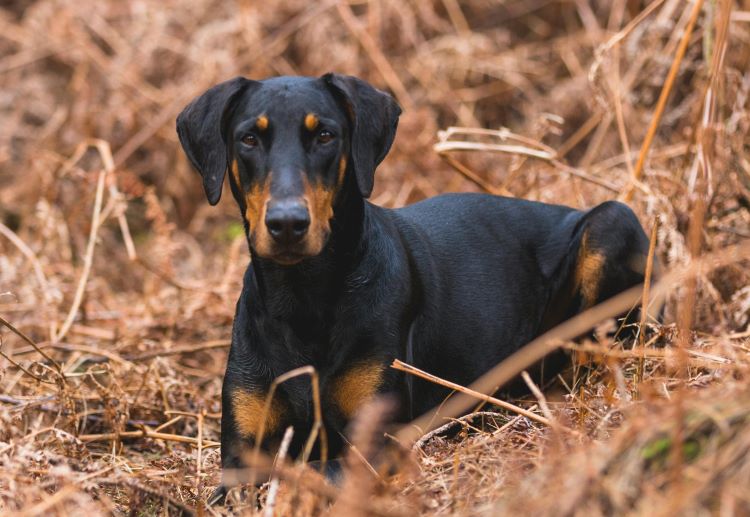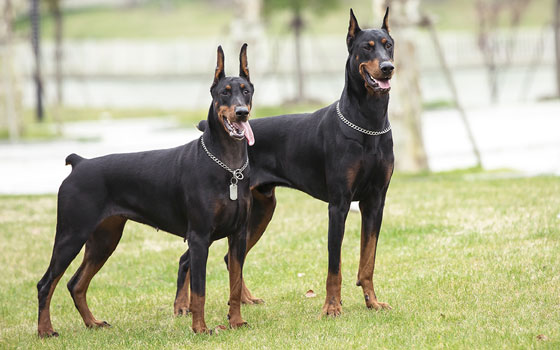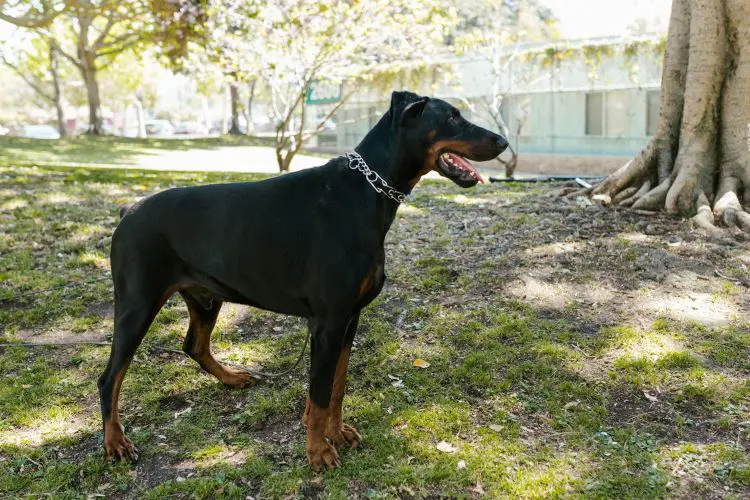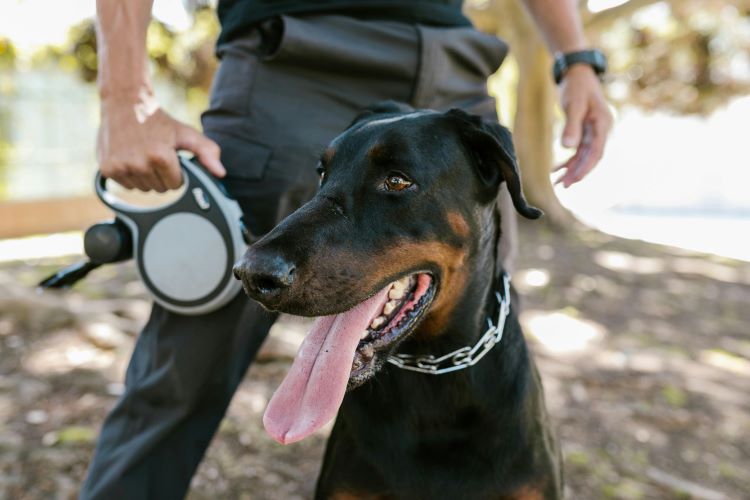Ready to help treat your pet to a healthy life?
Doberman Pinscher Breed Guide
By : Trupanion Staff | Updated Aug 14, 2024

The Doberman Pinscher is an often misunderstood dog breed. While widely associated with scary guard dogs, the truth is that Dobermans tend to be highly versatile pets and working canines, helping humans in a variety of different capacities. And of course, there's so much more than meets the eye!
A breed of many names, these dogs may be referred to as either the Doberman or Dobermann, Dobie, or Dobe. Interestingly, only the United States and Canada tend to tack on "Pinscher" when formally referring to these dogs. But no matter what you call them, these are fascinating dogs who've become recognized around the world for their high trainability and stoic nature. Whether you're wondering if a Dobie is the right dog for you or are simply curious about the breed as a whole, this Doberman Pinscher breed guide has you covered.
Get to know the Doberman Pinscher
The Dobie is known for its sleek, muscular build and distinctive brown markings on the face (especially those expressive eyebrows!), chest, and legs. This breed is also Dolichocephalic, which refers to its long and narrow skull/muzzle.
As for temperament, Dobermans might have a tough guy persona wrapped in a regal package, but they are quite the playful lovebugs with their family. Loyal and protective, they are more reserved when meeting new people. Once you’ve been accepted into their good graces, be prepared for a goofy companion that wants to be involved in your day-to-day life. Even though they’re a larger breed, Dobes often think of themselves as the perfect lap dog. Many will take every opportunity to cuddle with their person.
Similar dog breeds include the following:
- Rottweiler
- Boxer
- Miniature Pinscher
- Beauceron
- Great Dane
- Manchester Terrier
7 Fun facts about Dobermans
- Though Dobies are typically considered medium-size dogs, some can grow quite large! Full-grown members of this breed generally reach between 60 and 100 lbs. (27 - 45 kg). There are some extremely large, muscular variations known as the Warlock, King, and Goliath types, but these are the result of breeding Dobermans with big dog breeds like the Great Danes or the more muscular Rottweiler.
- The Doberman Pinscher was the official war dog of the United States Marine Corps in World War II. Dobermans and the other dog breeds used in the program were nicknamed “Devil Dogs.”
- A Doberman named “Cappy” saved 250 U.S. Marines in the Second Battle of Guam during World War II. He alerted them to the presence of Japanese soldiers and became one of the first K9 casualties when killed by a grenade. He is honored, along with 24 other Doberman Pinschers, with a statue sitting atop the World War II War Dog Memorial.
- This breed was originally developed by a tax collector (who also worked as the town’s dog catcher) named Karl Louis Dobermann. He wanted a dog to protect him as he went house-to-house collecting taxes.
- The Dobe is truly a melting pot of dog breeds. No one is quite sure the exact breed mix that Herr Dobermann used, and as the town’s dog catcher as well, he had quite a few options to add to the mix. Recent genetic studies point to the Rottweiler, Beauceron, German Pinscher, Weimaraner, and German Shepherd as being the foundation for the Doberman Pinscher.
- Dobermans are athletic, agile, and intelligent, which makes them perfect performers in Doberman Drill Teams. These teams have marched in parades and performed at halftime shows for decades, showing off the beauty of the breed.
- The Doberman Gang, a 1972 movie about a group of bank-robbing Dobes, showcased their trainability and gorgeous Hollywood-worthy looks.
Wait! What does 'Pinscher' mean?
As mentioned earlier, most parts of the world do not add "Pinscher" when referring to the Doberman dog breed. Since it is commonly used in North America though, what does it mean? To start, "Pinscher" is a German word that means "terrier." It comes from the English word "pincher", meaning one who pinches or nips.
Pinscher also refers to a category of dogs originating from Germany, characterized by their relatively compact size, smooth coat texture, and high energy levels. Along with the Doberman Pinscher, there's the Miniature Pinscher and the German Pinscher. While the three have some similarities in look and temperament, they are three different dog breeds. In order to better understand this, it's necessary to take a look at their history and development.

History of the Doberman Pinscher
Believe it or not, you can thank the taxman for the existence of the Doberman Pinscher breed. During the 1880s, Karl Friedrich Louis Dobermann, of Apolda, Germany, wanted an imposing and loyal dog to accompany him for his work as a tax collector. Reported to also work as the town’s dog catcher, he had ample choices in breeding a dog that would best fit the job. The exact breeds he used to create the Doberman Pinscher breed are debated, as he didn’t keep copious records of the process. Most agree their lineage includes the Rottweiler, Weimaraner, Black and Tan Terrier, German Pinscher, German Shepherd, and the Beauceron.
Whatever its parentage, the resulting Doberman was perfect for the job. Majestic and intimidating with its compact, muscular body, people would think twice before denying the taxman his due. After Dobermann’s death in 1894, a German dog breeder named Otto Goeller took on the task of refining the Dobermann dog and stabilizing it as a breed of its own. Because of this, it is Goeller whom many people credit as the breed's chief architect. Goeller went on to start the National Doberman Pinscher Club, and the breed grew in popularity throughout the 20th century.
Entry into North America
With Goeller refining the breed in Germany, it didn’t take long for the dog to make its way to the United States. In 1908, the first Doberman was registered with the American Kennel Club. However, it wasn’t until 1921 that the Doberman Pinscher Club of America was formed. Dobermans became a favorite breed for police and military work and were used as guard dogs for American soldiers throughout World War II. The breed continues to be an essential working dog in the 21st century, joining the search and rescue efforts after the 9/11 World Trade Center attacks.
Dobes also made their mark in the show ring, winning Best in Show at Westminster in 1939, 1952, and 1989. The breed has consistently ranked in the top 25 breeds in America, landing the spot of 15th most popular breed based on AKC registrations in 2023.
Behavior and training
Dobermans are most suited to experienced owners or those willing to dedicate the time and effort to training. Bred to be protective and with an intellect to match, it’s important they are set up for success. Training your Doberman should begin when they are a puppy and continue throughout their life.
When socialized and trained, a Doberman makes a wonderful companion who can do well in meeting new people. Unfortunately, their looks can be quite intimidating to many, and they’ve gotten a bad rap — often labeled aggressive. But if you invest the time and energy in positive reinforcement training and socialization, your Doberman can be a great ambassador of the breed.
Dobermans are eager to please their person and will do best with positive reinforcement training. They can be quite sensitive to methods that rely on force and punishment, which will damage the relationship they have with their family and can cause long term behavioral issues. Focus on rewarding what you want your Doberman to do and managing their surroundings to set everyone up for success.
Does the Doberman Pinscher play well with other dogs?
Proper proactive exposure to new sights, sounds, people, dogs, and other animals as a young puppy is essential for a Doberman’s socialization. Maintain this positive socialization for adult Dobes with new people and places. They can be territorial and protective of their family, so it’s essential to maintain positive associations with strangers.
Doberman Pinschers can do well with children if they have been properly introduced and socialized as a puppy. It’s important to make sure that children are polite and gentle when interacting with puppies and dogs. Young children and dogs should always be supervised, and it’s helpful for a dog to have their own “safe space” where they can go when they need some quiet time.
This breed will enjoy living with other animals in the home if socialized to them from puppyhood. Take care when introducing your well-socialized adult Doberman to other dogs and animals, as their size can be overwhelming. Dobe play can be quite rambunctious, which might be a bit too much for more cautious dog playmates. Carefully manage their playtime to ensure everyone is having a good time.
Exercise and mental enrichment needs
Daily exercise helps keep a Doberman healthy and gives them an outlet for their energy. Dobermans were bred to work and can go-go-go. Make sure they get enough exercise so they don’t engage in other unwanted behaviors. This breed will need at least an hour of exercise every day. Once fully grown, they can accompany you on your daily run and make great hiking buddies.
Speak with your veterinarian about appropriate exercise for a Doberman Pinscher puppy. Until they are full-grown (bone growth plates typically all close by around 12 to 18 months of age), minimize excessive strenuous or repetitive activities like jogging or running — as this can increase their risk of damage to the growing bone and cartilage, causing pain and future joint issues.
Like other dogs, a Doberman needs mental enrichment along with regular exercise. This breed is intelligent and loves to solve puzzles. Feeding regular meals with puzzle-bowls, providing interactive toys, and keeping their brain engaged with consistent positive reinforcement training will go a long way in preventing unwanted behaviors. Another great way to provide mental enrichment is to go on long walks where your Doberman can sniff to their heart’s delight.

Common behavioral issues
Due to their love of companionship, Dobermans need positive exposure to alone time from puppyhood,
to prevent or minimize any separation anxiety issues as they get older. It’s much easier to prevent than to treat once it’s started.
Make alone time a positive and relaxing experience for your Dobe.
Dog trainer tip
Any time you leave your Doberman puppy alone, pull out a frozen stuffed Kong or other yummy treat toys. When you return (even if only after thirty seconds), put it away until next time. This will help your Doberman learn that when you’re gone, awesome stuff happens, and they’ll make a positive association with your absence.
Activities for Doberman Pinschers
Dobermans do well in many different activities:
- Rally obedience
- Canine freestyle
- Agility
- Search and rescue
- Schutzhund training
Health and care tips
Doberman Pinschers are generally considered a healthy breed. Like all purebred dogs, however, they are prone to certain genetic health issues. With proper care, most Dobies can live long, healthy lives. Regular veterinary check-ups, a balanced diet, and sufficient exercise are nevertheless essential for maintaining their health. Responsible breeding practices that include health testing can help minimize the risk of these genetic conditions.
Common health conditions for the Doberman Pinscher
Every Doberman Pinscher is unique, but understanding what health conditions are likelier to occur can help you be a more prepared pet owner. Common health issues for Doberman Pinschers include (but are not limited to) the following:
- Cardiomyopathy
- Skin issues (like alopecia, demodectic mange, and lipoma)
- Ear infections
- Progressive eye conditions (like progressive retinal atrophy)
- Periodontal disease
- Hip Dysplasia and other orthopedic issues
- Bloat
- Hypothyroidism
You can predict what health conditions will happen to your pet, but you can take steps to prevent them. Keep up with regular veterinary visits, and sign up for dog insurance (preferably while your Doberman is still young, to make sure you're getting the most use out of your plan).
Grooming
While their rust-colored markings are quite distinctive for the breed, Doberman Pinschers come in 4 different coat colors: Black, Red, Blue (a diluted black), and Fawn (a diluted red). They have a smooth single-layer coat, which makes them susceptible to cold weather. They’ll appreciate a warm fleece or jacket during cold weather romping outside.
A Doberman’s sleek coat is easy to maintain, but will still shed. A weekly brushing will help keep that short fur from ending up around your house and help distribute natural oils throughout their coat to keep it healthy and shiny.
Regular nail trimming is needed to keep nails at the proper length. Dobermans have black nails, which can make it difficult to determine how much to clip without causing pain or bleeding. Nail grinding is a preferred trimming method for black nails.
Best Brush for a Doberman: Curry brush, Bristle brush
Ear cropping
Ear cropping has long been common for Dobermans. It is a surgical procedure that involves removing a portion from each ear and then binding the remaining portions to hard stands to make them heal in a way that stands up and pointed.
If you're a new Doberman Pinscher owner, you may find yourself wondering if your pet's ears should be cropped or not. After all, the breed standard seems to be a dog with thin, pointed ears that stand straight up, right? This was indeed the standard for these dogs in many parts of the world, but more recent decades have seen a shift toward leaving dog ears natural. This is because ear cropping can result in infections and other avoidable health conditions, and it is also seen as cruel and unnecessary by animal rights groups. Ear cropping is now illegal in most provinces of Canada and many other countries, but it remains legal in the U.S. as long as a licensed veterinarian performs it.
Laws are likely to continue changing when it comes to canine ear cropping, so it's important to be aware of what local restrictions may be in place if you're interested in it. However, it's also a good idea to consult with your veterinarian regardless about the potential risks. At the end of the day, Dobermans can be healthy, beautiful dogs with or without their ears being modified.

Doberman Pinschers in pop culture
Who's a good boy, and a star? The Doberman Pinscher; that's who!
Famous owners of the Doberman Pinscher
- William Shatner (Actor)
- Kevin Hart (Comedian)
- Mariah Carey (Singer)
- JFK (President)
- Bea Arthur (Actress)
- Rudolph Valentino (Actor)
- Victoria Principal (Actress)
- Jean-Christophe Novelli (Chef)
Famous Doberman Pinschers
Cappy was a Dobie who saved 250 U.S. Marines and died in the line of duty. He became the first dog to be buried in what eventually became the War Dog Cemetery.
Doberman Pinchers in media
- Rodney from It Shouldn’t Happen to a Dog
- Zeus & Apollo in Magnum PI
- Alpha from the Pixar movie, UP
- The dog from Eyes of an Angel
- Diablo from Beverly Hills Chihuahua
- The dogs from The Doberman Gang films
- Zeus from K-911
- The dog from the 2011 film, Hugo
